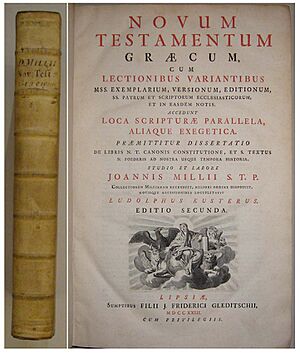John Mill (theologian) facts for kids
Quick facts for kids
John Mill
|
|
|---|---|
| Born | 1645 Shap, Westmorland, England
|
| Died | 23 June, 1707 (aged 61–62) England
|
| Occupation | Theologian, writer |
John Mill (born around 1645 – died June 23, 1707) was an English scholar. He is famous for creating a special edition of the Greek New Testament. This edition included notes on over 30,000 different readings found in old copies of the New Testament.
Contents
John Mill's Life Story
John Mill was born around 1645 in a place called Shap in Westmorland, England. In 1661, he started studying at Queen's College, Oxford, as a student helper. He earned his master's degree in 1669. That same year, he gave a special speech at the opening of the Sheldonian Theatre. Soon after, he became a Fellow at Queen's College.
Early Career and Roles
In 1676, Mill became a chaplain to the bishop of Oxford. A chaplain is like a personal priest or minister. In 1681, he became the rector of Bletchington, Oxfordshire. A rector is the head priest of a parish. He also became a chaplain to King Charles II.
From 1685 until he died, John Mill was the principal of St Edmund Hall, Oxford. A principal is the head of a college. In 1704, Queen Anne chose him for a special position at Canterbury. He passed away just two weeks after his important Greek New Testament book was published.
Mill's Work on the New Testament
John Mill is best known for his work as a textual critic. This means he carefully studied old copies of the New Testament to find the most accurate version. His main book was called Novum testamentum græcum, which means "The Greek New Testament." It was published in Oxford in 1707.
A Huge Project
Mill started this massive project with encouragement from John Fell, another scholar. It took Mill 30 years to finish! His book was a big step forward in understanding the New Testament. He used the text from an earlier scholar named Robertus Stephanus (from 1550). But Mill added many new notes. These notes included all the different readings that other scholars had found before. He also added a huge number of new differences he found himself by looking at many old manuscripts.
Finding Differences in Manuscripts
Mill's work was very important because he found over 30,000 differences between about 100 old New Testament manuscripts. These differences are called "variant readings." Imagine finding thousands of tiny changes in different copies of the same book!
His work showed how important it was to compare different old texts. He was the first to notice how helpful it was when Latin versions of the Bible agreed with a very old Greek manuscript called the Codex Alexandrinus. This hint was later used by another important scholar, Richard Bentley.
Facing Criticism
Mill's work was criticized by some people, like Daniel Whitby and Anthony Collins. Whitby argued that Mill's findings destroyed the truth of the Bible. However, Bentley defended Mill. Bentley pointed out that Mill didn't create the differences; he only showed them. Bentley also said that Christianity had survived for centuries despite these small errors, proving that Whitby's worries were not true.
John Mill's Published Works
- John Mill, Novum Testamentum Graecum, cum lectionibus variantibus MSS (Oxford 1707).
- In 1710, another scholar named Ludolf Küster reprinted Mill's Testament in Amsterdam. Küster added readings from twelve more manuscripts. You can find this version online here: Novum Testamentum Graecum, cum lectionibus variantibus MSS


